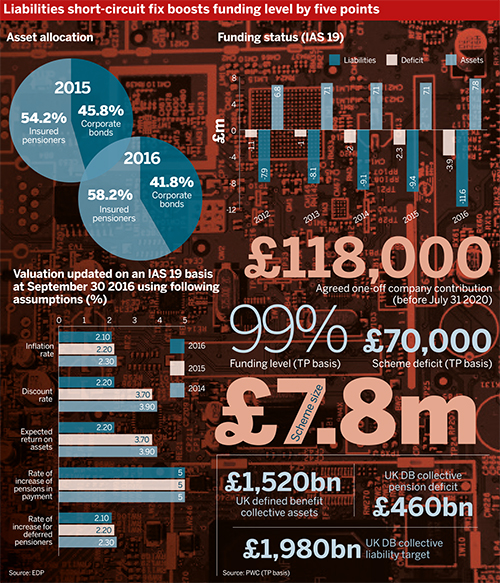The £7.8m Electronic Data Processing scheme has avoided a £420,000 addition to its liabilities, after a finalised actuarial valuation corrected an overstatement for certain deferred members.
The scheme actuary’s preliminary valuation report had indicated a deficit of £490,000 as of July 31 2016, representing a funding level of 94 per cent.
A 10-year deficit recovery plan, including receipt of company cash contributions of £75,000 a year, was drawn up.
A 5 per cent funding shift is unusual and significant
Mark Ashworth, Law Debenture Pension Trustees
Upon closer inspection of the data held for deferred members who had been in the pension scheme for less than five years, it was established that the liability for these members in the preliminary report had been overstated by £420,000.
The scheme’s deficit now stands at £70,000, with a funding level of 99 per cent. The overstatement announcement has come as the board of sponsor EDP conducts a strategic review of the business, which will include consideration of any offers to acquire the company. The review was delayed by its scheme valuation.
Carry out benefit audits
According to a statement on its website: “The company has agreed with the trustees to make a one-off contribution of up to a maximum of £118,000… in the event that the terminal bonus payments do not cover the deficit in full.” The company did not respond to requests for comment.

Of the 5 percentage point revision to the scheme’s funding level, Mark Ashworth, chair of Law Debenture Pension Trustees, said: “That sort of difference is, in my experience, unusual. That’s not to point the finger at anybody, but a 5 per cent funding shift is unusual and significant.”
Ashworth drew the distinction for inaccurate data between “getting the facts wrong” and “misunderstanding the nature of the benefits”. Speaking generally, he said data collection errors tended to be more frequent than calculation errors.
Schemes seeking to redress calculation errors “can audit the calculations to get somebody to go back and work them out from first principles”, he suggested. This often takes place when a scheme changes its administrator or actuary, he added.
Lifting a weight from the balance sheet
EDP is reviewing options to maximise shareholder value, one of which includes the possible sale of the company. The company’s website reads: “The uncertainty over the pension scheme valuation since March 2017 has impacted on the strategic review process and caused it to take longer than originally expected.” The reduction in its liabilities may make it easier to find a buyer.
Chris Tagg, partner in Barnett Waddingham’s pension administration practice, said a pension scheme deficit “makes it less attractive to a potential buyer because, effectively, it increases the value of the company and you’re just buying a liability rather than actual value”.
However, the revision of funding levels and its hindrance of the company-wide strategic review could equally deter suitors for the business.
Calum Cooper, head of trustee DB at consultancy Hymans Robertson, said: “Although you could argue financially that it’s good news, I think it’s also unsettling [and] potentially undermines confidence in any buyer in that business as to the extent of the liabilities or obligations that they’d be taking on if they bought the company.”
£100m bill still hangs over Morrisons as court seeks European help
The Court of Appeal has partially upheld an equalisation ruling that could add more than £100m to the liabilities of the Safeway Pension Scheme, but has asked a European court to clarify whether benefits can be revised downwards in certain circumstances.
Improving liability measurement
Gaining an insight into the health of members can help schemes improve their liability measurement.
They may consider medically underwritten mortality studies, which provide schemes with information on members’ health and longevity prospects. These increased in usage by 12 per cent between 2013 and 2016, according to the Pensions Institute.
Cooper cautioned against a long-term reliance upon so-called Mums. “These Mums exercises have a very short half life and they’re quite expensive. You’re asking a bunch of people about their health circumstances. That can be very different in three years’ time,” he said.














